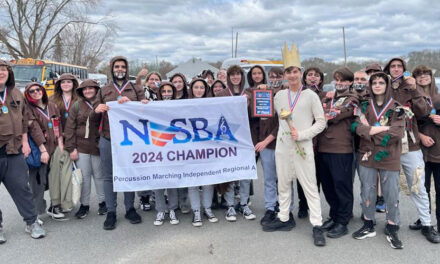Published January 16, 2020
By JILLIAN STRING
NORTH READING — North Reading High School (NRHS) Principal Anthony Loprete, along with faculty and students, shared their enthusiasm for personalized learning with School Committee members on Monday evening.
“There are a number of things that are happening at the high school. (We are) highlighting three tonight, specifically, around the idea of a more personalized approach to learning,” Loprete said. “It really is more about the how than the what, I think, in providing the best learning opportunity for students.”
Loprete stated that personalized learning focuses on six realms: Learner Profiles, Personal Connections, Competency Based Progression, Technology, Personal Learning Paths, and Flexible Learning Environments.
“A number of these (realms) are flowering at the high school,” Loprete said.
NRHS Universal Design for Learning (UDL) coaches Shellie Kerrigan and Andrew Falanga started off the presentations with “Empowering Educators Through UDL.”
“(UDL) has its roots in the architectural and building field. It’s a guiding set of principles that help make the curriculum accessible to all students,” Falanga said.

TEACHER AND UNIVERSAL Design for Learning coach Shellie Kerrigan (at podium) discusses the importance of personalized learning within the classroom setting. Pictured from left: Teacher and UDL coach Andrew Falanga, and ninth graders Annalise Butler and Angelina Palazzolo. (Jillian String Photo)
Kerrigan added that the goal of UDL is to get the students to become “expert learners,” and take charge of their own learning experiences.
Falanga noted that the district began using UDL during the 2018-2019 school year, and each school has two coaches.
“It’s a teacher-led initiative to get more teachers involved with implementing UDL strategies into their classrooms,” Falanga said.
During the 2018-2019 school year, a group of 10 teachers across five departments at NRHS began focusing on the principles of UDL, and providing options for students to choose how to express their understanding.
According to Falanga, the group observed lessons and met with UDL coach Emily Patt from the SEEM Collaborative.
Kerrigan stated that 27 teachers across six departments are participating for the 2019-2020 school year, and they have expanded their use of UDL in the classroom.
“After we worked with (Patt), we felt like teachers were doing a pretty good job with the representation piece, giving options for how students learn information, and then also the expression piece, how they show what they learned,” Kerrigan said. “We’re focusing more on the engagement part, like ‘Why are we learning it,’ which is the trickiest part to do, so that’s our focus for this year.”
Grade nine students Annalise Butler and Angelina Palazzolo discussed their experiences with UDL during Kerrigan’s Biology class.
“In Biology, all the projects we have, we can do a poem, or a video, or just anything like that,” Butler said. “It really helps students, including myself, to express themselves. It makes them feel like they’re not forced to one area. They can just be comfortable with what they’re learning and presenting.”
Butler added that when all of the students have to do the same assignment, it makes the topic seem insignificant.
Palazzolo agreed that having choices made concepts more interesting.
“Getting to choose the way you present your knowledge is really important,” Palazzolo said. “Depending upon the way you learn, you can present your knowledge in different ways. Some people might not be good at test taking, so it may be easier for them to make a project.”
School Committee Chairman Scott Buckley asked if projects were presented to the whole class, or just to the teacher.
Butler and Palazzolo stated that it depends upon the teacher and the project.
“In Biology, you get to choose. We did a rap, and we’re going to choose to present that,” Butler said.
Palazzolo added that essays would be an example of “teacher view” only.
Freshman Advisory
English teacher Evan Noce, who also serves as the Freshman Advisory Coordinator, discussed how the experience is personalized for each grade nine student.
“Every freshman at the high school is placed in an advisory power block, and we have four main goals while they’re in that advisory block,” Noce said.
Noce stated that the goals focus on transitions, both into high school and on to sophomore year, establishing adult connections within the building, developing and tracking progress toward personal goals, as well as identifying strengths and interests.
“The ultimate goal of all of this is helping the kids personalize their learning. That’s part of the UDL piece that (Falanga and Kerrigan) mentioned, and our thought is that by understanding their interests, strengths, and goals they can chart a course in their high school career that is fulfilling and successful,” Noce said.
School Committee member Rich McGowan inquired as to whether or not information from middle school was factored into the advisory program.
Noce stated that the students provide information from their middle school experiences.
Personalized physics
Physics teacher Thomas Ledoux uses current physics education research to design more personalized lessons for students.
“The bread and butter of any physics course, if you’ve taken one, was probably the end of chapter textbook problems,” Ledoux said. “In 2002, Kim and Pak did a study that showed correlation between the number of textbook problems solved and conceptual understanding… there was no correlation between the number of problems (students) solved out of a textbook and their conceptual understanding of a topic.”
Armed with this knowledge, Ledoux provides laboratory experiences for students to help them visualize and understand physics concepts more thoroughly.
“One of the things that really helps us students learn and grasp knowledge are labs,” physics student Brendan Witts said. “When you can physically see (concepts), it gets you motivated to learn.”
Witts, along with classmates Ian Miller and Natalie Gonthier, showed video clips of some of the student labs.
“Another good thing that I find helpful with the labs and the practicums is that it takes these weird, abstract, and complicated concepts and formulas that we learn in class and it applies it to a real world thing,” Miller said.
Gonthier noted that the labs help with AP exams as well.
“The thing I find most helpful about these labs is that you’re familiar with seeing how to set something up, so when it comes time for the AP exam, you’re more familiar with how to set up something in order to get (certain) variables,” Gonthier said.
Buckley stated that it was refreshing to see teachers who are heavily invested in what they do, and he noted the trend over the past few years for more hands on learning opportunities.
“It just seems like the learning is better when you do things hands on,” Buckley said.




